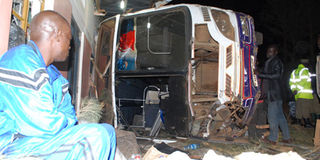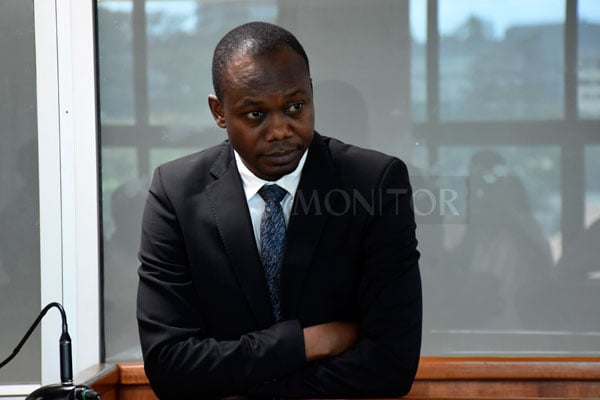Prime
Why bus accident rates are dropping

Police and passengers at a site of a bus accident recently. FILE PHOTO
What you need to know:
In more than 10 years, the high number of injuries and fatalities suffered in road accidents have been a constant in the statistics. However, there is a silver lining in the dark cloud as the number of accidents decline.
The past decade, between 2000 and 2010, was a disastrous one for public vehicles on Ugandan roads with a high numbers of injuries and deaths recorded. More than 30 passengers, like it was at Nyakarindi on Kabale-Katuna Road in June 2005, would die in one accident. But, in the last three years, such numbers have been on the downward curve.
The accidents and fatalities have dropped to an extent that the average monthly deaths five years ago are higher than are now recorded annually.
Police Traffic and Road Safety Director, Dr Steven Kasiima, says fatalities in bus accidents have dropped for the third year running.
“Bus passenger deaths decreased by 27 per cent in 2014 (17 passengers). These are the fruits of vigilance and enforcement of the new laws. It is good news for traffic enforcers, bus owners and passengers who use them,” Dr Kasiima says.
The statistics
The bus passenger deaths dropped from 24 recorded in 2013 to 17 in 2014.
Dr Kasiima adds that bus injuries records in 2014 are even lower than 2013. The number of bus passengers injured also fell from 541 people in 2012 to 473 in 2013.
However, he does not provide details because the 2014 Crime and Traffic Safety Report, has not yet been officially released by the Inspector General of Police.
In 2013, 392 bus accidents were registered, which was a 15.7 per cent decrease from 465 accidents recorded in 2012. Traffic statistics that are yet to be released in the 2014 Crime and Traffic Safety report also indicate a continued downward curve in bus accidents, Dr Kasiima says.
Interestingly, as buses crashed and subsequent deaths dropped, the number on the road is increasing. From the new Transport Licensing Board (TLB) statistics puts number of buses operating in Uganda at 1,800. Five years ago, there were only 800 buses.
Unchecked
The big question is: What has led to the decrease in fatalities in bus accidents?
Previously, several traffic regulations had been tried to curb bus accidents in vain. In 2007, it was believed that the accidents were a result of speeding and the fatalities were due to lack of seat belts for passengers.
So, the government enforced speed governors and seat belt in buses and ensured that implementation was 95 per cent. Fatalities remained unchecked.
Mr Winstone Katushabe, the secretary Transport Licensing Board, says the regulations still had gaps. “A bus driver would crash a bus and kill tens of passengers and leave them there. In a few months, he is hired by another bus company where he is given charge of another bus,” Mr Katushabe says. “And the cycle would go on and on”.
Police and TLB would go for bus owner by grounding the entire fleet or subject it to inspection. Often these actions were detrimental both to the passengers and bus owners.
Some areas could only be accessed by certain bus services. The pains of grounding the entire bus fleet would spread all the way to business in some areas.
No interface
Affected passengers run to their political representatives who also put pressure on authorities to relax enforcement of stricter regulations.
Bus operators aware of this, they would all park their buses until police or TLB operations are halted.
With public transport in chaos and passengers going upcountry stranded, law enforcers were left with no option but to either suspend the regulations or relax them as they look for other alternatives.
Mr Hannington Kiwanuka, a bus driver and Chairman Uganda Bus Driver and Allied Association (UBDAA), says there was no interface between bus operators, police, and TLB.
“The only language police and TLB used was to delicense or ground the fleet if a bus was involved in an accident. Then the bus operators would respond by striking,” Kiwanuka notes.
The Transport ministry once had to lift a ban imposed on a bus company by police and TLB after its buses had been involved in several fatal accidents.
Public dialogues
Faced with challenges from within and out the police, TLB looked for new ways. Mr Katushabe says they needed to bring bus operators and enforcers together to get a common ground through public hearings.
“Bus drivers, traffic police officers and TLB officers met regularly. Operational mistakes on each side were brought out and solutions found through the same process,” he says.
For long, bus drivers had been locked out of decision making.
Kiwanuka says during public dialogues they told authorities that accidents would only be reduced if there were regulations that guaranteed job security of drivers.
“Bus drivers had become instruments for violation of road regulations because bus owners threatened them with sackings,” Kiwanuka says.
Drivers used to abide by the bosses’ directive to save their jobs. A driver would make a return journey even if they were tired. The result would be dozing off the steering and causing an accident.
Other drivers would first load passengers and then drive to the garages to rectify any mechanical problem.
Public hearings gave the authorities a guide on how to fill the gaps. In 2013, TLB and Ministry of Transport introduced in a new regulation to protect bus drivers and owners and also tighten accountability.
“The instrument made bus drivers, owners, traffic police officers and transport officials share responsibilities to have a safe public transport industry,” Katushabe says.
New rules
In the instrument, a bus owner has to give an appointment letter to his or her drivers. The driver has to attach it to his application to the TLB if he or she is to be given a badge that allows him or her to drive a bus.
Traffic police and TLB officials have to verify the driver’s competency to drive and their driving record. A driver with more than two accident cases in his or her records doesn’t get a badge. Therefore he or she isn’t allowed to drive a bus.
A badge and the photograph of the driver of a specific bus must also be displayed inside the bus where the passengers can view.
“The regulation helped us to bring the bus owner and the driver together to understand that if one faults the regulations and is caught on the wrong side of the law, then another is directly affected,” Katushabe points out.
Enforcement
If a bus driver is involved in accidents due to his or her mistakes, the badge is withdrawn thus gaining unemployment.
In a way, Katushabe says, the fear of losing their jobs has been transmitted to the bus drivers’ right feet when they step on the gas pedal.
Kiwanuka says: “When TLB and police involved us, our drivers started exposing their bosses who have been forcing them to drive return journeys. Drivers started tipping police about buses in dangerous mechanical condition and bosses who pester them to speed”.
Since the enforcement of the new laws, Dr Kasiima says, drivers reporting to him their bosses who want them to connive to flout the laws.
“I got a call from driver report his boss who was forcing him to make a return journey. I intervened and stopped the bus,” he recalls.
Positive attitude
He adds the mid-term bus accident reports, especially on fatalities, are better than those they registered in the same period last year.
“Even bus owners have now realised that the biggest beneficiaries of regulations that have led to the reduction in bus accidents and fatalities were themselves. Many bus owners are positive about what we are doing,” Dr Kasiima says.
Most buses are bought on loans and every owner’s wish to ensure that he or she makes the money to pay back. Often, loan repayment come with pressures ok bus owners in turn pressure the bus drivers.
Bus owners, drivers say, order them to speed or make return journeys and overload so that they are able to pay back in time.
“You couldn’t deal with speeding by route charts alone without tackling competition. We are now ensuring that there is a time table for buses operating on the same route. No rival buses can load passengers or set off at the same time,” he says.
Charles Byamugisha, the owner of Baby Coaches, whose buses often got involved in accidents, says their drivers have been critical in reducing fatalities.
Optimistic
“We talked to our drivers to reduce speed. You don’t have rule out the bad roads full of potholes then as the major cause of accidents. The road network has improved so have the accidents,” Mr Byamugisha says.
A bus owned by Baby Coaches last had a major accident in Uganda last year.
Largely, reduction in accidents was done through dialogue than enforcement. Dr Kasiima says the favourable statistics brings confidence back to the industry that was once seen as a death trap.
“I can tell you that if we continue with this plan, we may have zero causalities as a result of avoidable circumstance in buses for some years,” he asserts.
Highest decline in road carnage in more than a decade
“The year 2013 saw a 7.6 per cent decrease in the total number of fatal and serious accidents and is the highest decrease recorded in the last 11 years. Traffic Police have deployed dedicated enforcement teams targeting major causes of accidents such as over speeding, drunk driving and incompetent drivers.
This is over and above our daily enforcement against road users who choose to ignore traffic rules and endanger themselves and other road users.
Improving road safety is, ultimately, a joint effort between the community and the Police. This, we shall con tinue with our road safety outreach through our annual programs and campaigns to strengthen our partnership with the community. We shall also continue to benchmark and learn from the best practices so as to, continually, achieve greater heights in excellence, making Uganda roads safer and secure.”
2013 Crime and Traffic Safety Report i
24 Number of deaths in bus accidents that were recorded in 2013
17 Number of deaths in bus accidents that were recorded in 2014
465 number of bus accidents recorded in 2012
392 number of bus accidents recorded in 2013




